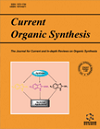- Home
- A-Z Publications
- Current Organic Synthesis
- Previous Issues
- Volume 20, Issue 4, 2023
Current Organic Synthesis - Volume 20, Issue 4, 2023
Volume 20, Issue 4, 2023
-
-
The Synthetic Approaches for Preparation of Indigo and Applications in Denim Industry
More LessAuthors: Gökhan Kaplan and Zeynel SeferoğluThis paper describes indigo chemistry and its brief scientific history beginning with the first characterization and chemical synthesis of indigo via various precursors such as isatin, cinnamic acid, 2-nitrobenzaldehyde, anthranilic acid, N-phenylglycine, aniline, and indole. Furthermore, alternative methods such as eco-friendly microbial synthesis of indigo using a variety of enzymes are reported: Cytochrome P450 mono Read More
-
-
-
Copper Supported Imidazolylpyridine Modified SPION as an Efficient Catalyst for Eco-friendly, One-pot and Green Synthesis of Novel (3- Cyanothiophen-2-yl)-N-(arylsulfonyl)acetimidamide Derivatives
More LessAuthors: Mohammad Askarzadeh, Mehdi Adib and Mohammad MahdaviBackground: In this paper, a novel catalyst is synthesized and characterized by immobilizing copper onto imidazopyridine-modified superparamagnetic iron oxide nanoparticles (SPION). Methods: The catalyst is characterized by several methods, including TEM, SEM, ICP, DLS, and VSM. The catalytic activity of the catalyst is evaluated in the synthesis of thiosolfunamide. The synthesized catalyst showed very good ac Read More
-
-
-
Recent Developments in the Synthesis and Anticancer Activity of Indole and Its Derivatives
More LessAuthors: Balwinder Kaur, Sneha Venugopal, Anil Verma, Sanjeev K. Sahu, Pankaj Wadhwa, Deepak Kumar and Ajit SharmaHeterocyclic compounds are a class of compounds that is deeply intertwined with biological processes and is found in about 90% of commercially available medicines. They serve a critical function in medicinal chemistry and are focused in the field of medication development for their intensive research due to their broad variety of biological effects because of their intriguing molecular architecture, such as indoles are good can Read More
-
-
-
An Exhaustive Compilation on the Synthesis of Heterocycles Pendant on the Fatty Acid Alkyl Chains
More LessAuthors: Afaf Y. Khormi, Refat El-sayed, Thoraya A. Farghaly, Mohamed R. Shaaban and Ahmad M. FaragFatty acids derived from oils and fats of different plant and animal resources are considered one of the most valuable renewable precursors of the synthetic chemical and pharmaceutical industries. On the other hand, heterocyclic compounds are well known nowadays by their constitution of many commercialized drugs due to their unique biological activities. Combination between fatty acids and heterocyclic compounds has Read More
-
-
-
Synthesis, Characterization and Biological Activity of Benzimidazoleacrylonitrile Derivatives
More LessAuthors: Mehtab Parveen, Mohammad Azeem, Afroz Aslam, Mohammad Haris, Amir Khan and Mahboob AlamBackground: Benzimidazoles have a wide range of synthetic applications in medicinal chemistry and biological activities like anti-tumor/anti-proliferative activities etc. Moreover, different heterocyclic moieties attached to the benzimidazole ring improved anticancer activities. Methods: All the chemicals were purchased from Aldrich Chemical Company, are of AR grade and used as received. Microanalytical data (C, H, and N Read More
-
-
-
Green Synthesis of Mono, Bis and Tris Aminobenzochromenes and Benzopyranochromenes using Fe3O4@Sio2@ Vanillin/Vitamin B1 Nanoparticles: A New, Mild, Simple and Effective Bronsted Acid Catalyst for the Synthesis of Chromenes
More LessAuthors: Leila Z. Fekri, Mohaddeseh Kadivar-Kalmarzi and Zahra Hojjati-ZolpiraniObjective: Vanillin/Vitamin B1 (Thiamine) supported Fe3O4@Sio2 nanoparticles (Fe3O4 @SP@VT) were synthesized and thoroughly analyzed, and were used for the green and efficient synthesis of chromenes using the multicomponent reaction of aldehyde, malononitrile and 4-hydroxy coumarin, as well as the multicomponent reaction of aldehyde, α-naphthol or β–naphthol and 4-hydroxy coumarin. Methods: The reactio Read More
-
-
-
Synthesis of Misoprostol, and Intramolecular Isomerization of A-Type Misoprostol into B-Type Misoprostol using 1, 8-Diazabicyclo [5.4.0] undec- 7-ene (DBU)
More LessObjective: Misoprostol is a synthetic prostaglandin that is related structurally to naturally occurring prostaglandin (PG), and it has been acknowledged as an effective inhibitor of gastric acid secretion when administered intravenously. Methods: In the present study, the novel application of 1,8-Diazabicyclo[5.4.0]undec-7-ene, a cyclic unsaturated amine [DBU] for the conversion of A-type Misoprostol (A-MP) to Read More
-
Volumes & issues
-
Volume 22 (2025)
-
Volume 21 (2024)
-
Volume 20 (2023)
-
Volume 19 (2022)
-
Volume 18 (2021)
-
Volume 17 (2020)
-
Volume 16 (2019)
-
Volume 15 (2018)
-
Volume 14 (2017)
-
Volume 13 (2016)
-
Volume 12 (2015)
-
Volume 11 (2014)
-
Volume 10 (2013)
-
Volume 9 (2012)
-
Volume 8 (2011)
-
Volume 7 (2010)
-
Volume 6 (2009)
-
Volume 5 (2008)
-
Volume 4 (2007)
-
Volume 3 (2006)
-
Volume 2 (2005)
-
Volume 1 (2004)
Most Read This Month
Article
content/journals/cos
Journal
10
5
false
en


